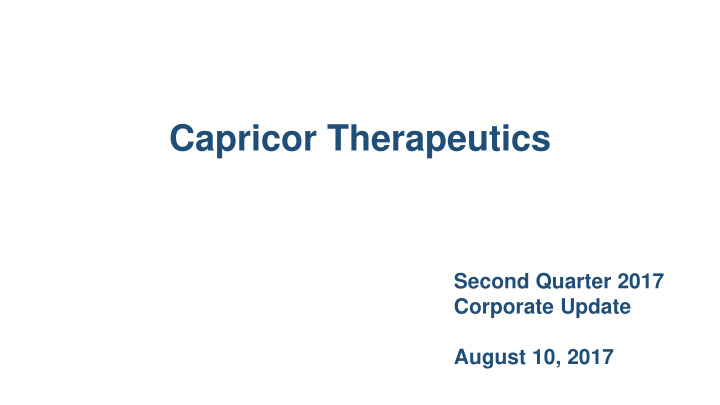



Capricor Therapeutics Second Quarter 2017 Corporate Update August 10, 2017
Forward-Looking Statements Statements in this press release regarding the efficacy, safety, and intended utilization of Capricor's product candidates; the initiation, conduct, size, timing and results of discovery efforts and clinical trials; the pace of enrollment of clinical trials; plans regarding regulatory filings, future research and clinical trials; plans regarding current and future collaborative activities and the ownership of commercial rights; scope, duration, validity and enforceability of intellectual property rights; future royalty streams, expectations with respect to the expected use of proceeds from the recently completed offerings and the anticipated effects of the offerings, and any other statements about Capricor's management team's future expectations, beliefs, goals, plans or prospects constitute forward-looking statements within the meaning of the Private Securities Litigation Reform Act of 1995. Any statements that are not statements of historical fact (including statements containing the words "believes," "plans," "could," "anticipates," "expects," "estimates," "should," "target," "will," "would" and similar expressions) should also be considered to be forward-looking statements. There are a number of important factors that could cause actual results or events to differ materially from those indicated by such forward-looking statements. More information about these and other risks that may impact Capricor's business is set forth in Capricor's Annual Report on Form 10-K for the year ended December 31, 2016, as filed with the Securities and Exchange Commission on March 16, 2017, and in its Registration Statement on Form S-3, as filed with the Securities and Exchange Commission on September 28, 2015, together with prospectus supplements thereto, and in its Quarterly Report on Form 10-Q for the quarter ended March 31, 2017, as filed with the Securities and Exchange Commission on May 15, 2017. All forward-looking statements in this press release are based on information available to Capricor as of the date hereof, and Capricor assumes no obligation to update these forward-looking statements. 2
CDCs Possess Broad Bioactivity Property References ✓ Regenerative 1,2 ✓ Anti-fibrotic 1-4 ✓ Anti-apoptotic 3-5 ✓ Angiogenic 1,6 ✓ Anti-inflammatory 9 ✓ Immunomodulatory 9,10 1. Smith et al. Circulation 2007 ; 115 :896-908. 6. Chimenti et al. Circ Res 2010 ; 106 :971-80. 2. Makkar et al. Lancet 2012 ; 379 :895-904. 7. Malliaras et al. Circulation 2012 ; 125 :100-12. 3. Tseliou et al. PLoS One 2014 ; 9 :e88590. 8. Malliaras et al. EMBO Mol Med 2013 ; 5 :191-209. 4. Tseliou et al. Basic Res Cardiol 2014 ; 109 :443. 9. Aminzadeh et al. Eur Heart J 2015 ; 36 :751-62. 5. Li et al. J Am Coll Cardiol 2012 ; 59 :942-53. 10. Lauden et al. Circ Res 2013 ; 112 :451-64. 3
Evolution of Capricor’s Science and Clinical Development Elucidation of Mechanism Retention and Paracrine Exosomes Engraftment (c-Kit) (growth factors) (RNA, proteins) 2006 2017 Fibrosis, Apoptosis, Regeneration Inflammation, Oxidative Stress, Mitochondrial Structure & Function CADUCEUS DYNAMIC ALLSTAR HOPE-Duchenne RESTORE-DMD Progression of Clinical Trials 4
DMD Pathophysiology Oxidative Dystrophin deficiency Stress Loss of membrane stability Inflammation Mitochondrial Dysfunction Impaired Muscle Necrosis Regeneration Degeneration Fibrosis Muscle Wasting Loss of Function Adapted from Guiraud et al. Curr Opin Pharmacol 2017 ; 34 :36-48. 5
Cardiac and Ambulatory Effects of CDCs in mdx Model High-Intensity Treadmill Exercise Injection #1 Injection #2 WT 90 WT 1000 Mdx+CDC Ejection Fraction (%) Mdx+CDC Mdx+Vehicle 80 Distance (m) Mdx+Vehicle 800 70 600 60 400 *** 50 * * # # # # # # 200 # # # # 40 * * 30 0 BL 3 4 5 6 7 8 9 10 11 12 Weeks # p<0.005 vs. Mdx+CDC * p<0.05 vs. Mdx+CDC; *** p<0.005 vs. Mdx+CDC LV ejection fraction markedly improved after Ambulatory capacity doubled; the substantial increase in treatment either with CDC or CDC-exosomes exercise capacity was disproportionate to the compared to vehicle-treated mice (p<0.005) improvement in cardiac function (EF increased by <10%) 6 Adapted from pre-publication manuscript (Aminzadeh et al, http://biorxiv.org/content/early/2017/04/20/128900).
CAP- 1002’s Activities in DMD… and Potentially Beyond Duchenne Muscular Dystrophy Inflammation Oxidative Stress Mitochondrial potential to address a variety CAP-1002 Dysfunction of rare pediatric diseases Apoptosis other muscular dystrophies Fibrosis limb-girdle disorders cystic fibrosis 7
Recommend
More recommend